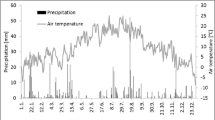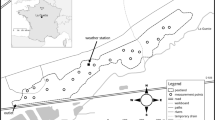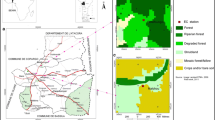Abstract
The carbon pool of peatlands has been considered as potentially unstable in a changing climate. This study is the first presenting carbon dioxide (CO2) net ecosystem exchange, CO2 efflux due to ecosystem respiration and CO2 uptake by gross primary production over a complete growing season for different microforms of a boreal peatland in Russia (61°56′N, 50°13′E). CO2 fluxes were measured using the closed chamber technique from the 25th April in the period of snow melt until the end of the vegetation period and the first frost on the 20th October 2008 at seven different microform types: minerogenous and ombrogenous hollows, lawns and hummocks, respectively, and Carex lawns situated in a transition zone between minerogenous and ombrogenous mire parts. The total number of chamber flux measurements was 5,517. Ombrogenous hummocks and lawns were sources of CO2 over the investigation period whereas hollows and minerogenous lawns were CO2 sinks. Some plots of Carex lawns and minerogenous hummocks were sinks while other plots of these microform types were sources. The CO2 fluxes were characterised by large variability not only between the microform types but also within the respective microform types. Of all microform types, the Carex, ombrogenous, and minerogenous lawns showed the highest variability in CO2 fluxes, which is probably related to a stronger within-microform heterogeneity in vegetation composition and coverage as well as in the water table level. Air temperature was one of the dominant controls on the CO2 flux dynamics. Water table and green area index were found to have strong influence on CO2 fluxes both within different patches of the same microform type as well as between different microforms.











Similar content being viewed by others
References
Adamec L (1995) Photosynthetic inorganic carbon use by aquatic carnivorous plants. Carniv Pl Newslett 24(2):50–53
Alm J, Talanov A, Saarnio S, Silvola J, Ikkonen E, Aaltonen H, Nykänen H, Martikainen PJ (1997) Reconstruction of the carbon balance for microsites in a boreal oligotrophic pine fen, Finland. Oecologia 110:423–431
Alm J, Schulman L, Walden J, Nykänen H, Martikainen PJ, Silvola J (1999) Carbon balance of a boreal bog during a year with an exceptionally dry summer. Ecology 80(1):161–174
Apps MJ, Kurz WA, Luxmoore RJ, Nilsson LO, Sedjo RA, Schmidt R, Simpson LG, Vinson TS (1993) Boreal forests and tundra. Water Air Soil Pollut 70:39–53
Arneth A, Kurbatova J, Kolle O, Shibistova OB, Lloyd J, Vygodskaya NN, Schulze E-D (2002) Comparative ecosystem-atmosphere exchange of energy and mass in a European Russian and central Siberian bog II. Interseasonal and interannual variability of CO2 fluxes. Tellus 54B:514–530
Aurela M, Laurila T, Tuovinen J-P (2002) Annual CO2 balance of a subarctic fen in northern Europe: importance of the wintertime efflux. J Geophys Res 107(D21). doi:10.1029/2002JD002055
Aurela M, Laurila T, Tuovinen J-P (2004) The timing of snow melt controls the annual CO2 balance in a subarctic fen. Geophys Res Lett 31. doi:10.1029/2004GL020315
Bubier JL, Frolking S, Crill PM, Linder E (1999) Net ecosystem productivity and its uncertainty in a diverse boreal peatland. J Geophys Res 104(D22):27683–27692
Bubier JL, Crill PM, Mosedale A, Frolking S, Linder E (2003a) Peatland responses to varying interannual moisture conditions as measured by automatic CO2 chambers. Glob Biogeochem Cycles 17(2). doi:10.1029/2002GB001946
Bubier JL, Bhatia G, Moore TR, Roulet NT, Lafleur PM (2003b) Spatial and temporal variability in growing-season net ecosystem carbon dioxide exchange at a large peatland in Ontario, Canada. Ecosystems 6:353–367
Franzén LG (2006) Increased decomposition of subsurface peat in Swedish raised bogs: are temperate peatlands still net sinks of carbon? Mires Peat 1: article 3
Friborg T, Christensen TR, Søgaard H (1997) Rapid response of greenhouse gas emission to early spring thaw in a subarctic mire as shown by micrometeorological techniques. Geophys Res Lett 24(23):3061–3064
Golovatskaya EA, Dyukarev EA (2009) Carbon budget of oligotrophic mire sites in the southern Taiga of west Siberia. Plant Soil 315:19–34
Gorham E (1991) Northern peatlands: role in the carbon cycle and probable responses to climatic warming. Ecol Appl 1:182–195
Griffis TJ, Rouse WR, Waddington JM (2000) Scaling net ecosystem CO2 exchange from the community to landscape-level at a subarctic fen. Glob Change Biol 6:459–473
Heikkinen JEP, Virtanen T, Huttunen JT, Elsakov V, Martikainen P (2004) Carbon balance in east European tundra. Glob Biogeochem Cycles 18. doi:10.1029/2003GB002054
Johnson LC, Shaver GR, Giblin AE, Nadelhoffer KJ, Rastetter ER, Laundre JA, Murray GL (1996) Effects of drainage and temperature on carbon balance of tussock tundra microcosms. Oecologia 108:737–748
Kettunen A (2000) Short-term carbon dioxide exchange and environmental factors in a boreal fen. Verh Internat Verein Limnol 27:1–5
Kutzbach L, Wille C, Pfeiffer E-M (2007a) The exchange of carbon dioxide between wet arctic tundra and the atmosphere at the Lena river delta, northern Siberia. Biogeosciences 4:869–890
Kutzbach L, Schneider J, Sachs T, Giebels M, Nykänen H, Shurpali N, Martikainen P, Alm J, Wilmking M (2007b) CO2 flux determination by closed-chamber methods can be seriously biased by inappropriate application of linear regression. Biogeosciences 4:1005–1025
Laine A, Sottocornola M, Kiely G, Byrne KA, Wilson D, Tuittila E-S (2006) Estimating net ecosystem exchange in a patterned ecosystem: example from blanket bog. Agric For Meteorol 138:231–243
Larmola T, Alm J, Juutinen S, Saarnio S, Martikainen PJ, Silvola J (2004) Floods can cause large interannual differences in littoral net ecosystem productivity. Limnol Oceanogr 49(5):1896–1906
Lindroth A, Lund M, Nilsson M, Aurela M, Christensen TR, Laurila T, Rinne J, Riutta T, Sagerfors J, Ström L, Tuovinen J-P, Vesala T (2007) Environmental controls on the CO2 exchange in north European mires. Tellus 59B:812–825
Moore TR, Bubier JL, Frolking SE, Lafleur PM, Roulet NT (2002) Plant biomass and production and CO2 exchange in an ombrotrophic bog. J Ecol 90:25–36
Moore TR, Lafleur PM, Poon DMI, Heumann BW, Seaquist JW, Roulet NT (2006) Spring photosynthesis in a cool temperate bog. Glob Change Biol 12:2323–2335
Oechel WC, Hastings SJ, Vourlitis G, Jenkins M, Reichers G, Grulke N (1993) Recent change of arctic tundra ecosystems from a net carbon dioxide sink to a source. Nature 361:520–523
Panikov NS, Dedysh SN (2000) Cold season CH4 and CO2 emission from boreal peat bogs (west Siberia): winter fluxes and thaw activation dynamics. Glob Biogeochem Cycles 14(4):1071–1080
Riutta T, Laine J, Aurela M, Rinne J, Vesala T, Laurila T, Haapanala S, Pihlatie M, Tuittila E-S (2007a) Spatial variation in plant community functions regulates carbon gas dynamics in a boreal fen ecosystem. Tellus 59B:838–852
Riutta T, Laine J, Tuittila E-S (2007b) Sensitivity of CO2 exchange of fen ecosystem components to water level variation. Ecosystems 10:718–733
RWS (2009) Russia’s Weather Server: http://meteo.infospace.ru/wcarch/html/e_day_stn.sht?num=518. Accessed 30 June 2010
Sagerfors J, Lindroth A, Grelle A, Klemendtsson L, Weslien P, Nilsson M (2008) Annual CO2 exchange between nutrient-poor, minerotrophic, boreal mire and the atmosphere. J Geophys Res 113. doi:10.1029/2006JG000306
Schneider J, Kutzbach L, Schulz S, Wilmking M (2009) The closed chamber method overestimates CO2 respiration fluxes in low-turbulence nighttime conditions. J Geophys Res 114. doi:10.1029/2008JG000909
Schreader CP, Rouse WR, Griffis TJ, Boudreau LD, Blanken PD (1998) Carbon dioxide fluxes in a northern fen during a hot dry summer. Glob Biogeochem Cycles 12(4):129–140
Schulze E-D, Prokuschkin A, Arneth A, Knorre N, Vaganov EA (2002) Net ecosystem productivity and peat accumulation in a Siberian Aapa mire. Tellus 54B:531–536
Shurpali NJ, Verma SB, Kim J (1995) Carbon dioxide exchange in a peatland ecosystem. J Geophys Res 100:14319–14326
Silvola J, Alm J, Ahlholm U, Nykänen H, Martikainen PJ (1996) The contribution of plant roots to CO2 fluxes from organic soils. Biol Fertil Soils 23:126–131
Valentini R, Dore S, Marchi G, Mollicone D, Panfyorov M, Rebmann C, Kolle O, Schulze E-D (2000) Carbon and water exchanges of two contrasting central Siberia landscape types: regenerating forest and bog. Funct Ecol 14:87–96
Van der Molen MK, van Huissteden J, Parmentier FJW, Petrescu AMR, Dolman AJ, Maximov TC, Kononov AV, Karsanaev SV, Suzdalov DA (2007) The growing season greenhouse gas balance of a continental tundra site in the Indigirka lowlands, NE Siberia. Biogeosciences 4:985–1003
Waddington JM, Roulet NT (1996) Atmosphere-wetland carbon exchanges: scale dependency of CO2 and CH4 exchange on the developmental topography of a peatland. Glob Biogeochem Cycles 10(2):233–245
Waddington JM, Roulet NT (2000) Carbon balance of a boreal patterned peatland. Glob Change Biol 6:87–98
Wallen B, Falkengren-Grerup U, Malmer N (1988) Biomass, productivity and relative rate of photosynthesis of Sphagnum at different water levels on a south Swedish peat bog. Holarct Ecol 11:70–76
Willmott CJ (1982) Some comments on the evaluation of model performance. Bull Am Meteorol Soc 63:1309–1313
Wilson D, Alm J, Riutta T, Laine J, Byrne KA, Farrell EP, Tuittila E-S (2007) A high resolution green area index for modelling the seasonal dynamics of CO2 exchange in peatland vascular plant communities. Plant Ecol 190:37–51
Wolf U (2009) Above- and belowground methane dynamics of a boreal peatland ecosystem of varying vegetation composition during summer in the Republic of Komi, Russia. Master thesis, University of Göttingen
Yurova A, Wolf A, Sagerfors J, Nilsson M (2007) Variations in net ecosystem exchange of carbon dioxide in a boreal mire: modeling mechanisms linked to water table position. J Geophys Res 112. doi:10.1029/2006JG000342
Zamolodchikov DG, Karelin DV, Ivaschenko AI, Oechel WC, Hastings SJ (2003) CO2 flux measurements in Russian far east tundra using eddy covariance and closed chamber techniques. Tellus 55B:879–892
Acknowledgments
We gratefully acknowledge the contribution of M. Gažovič, J. Ibendorf, O. Michajlov, M. Miglovec, P. Schreiber, C. Wille and U. Wolf for assisting us in carrying out the CO2 flux chamber measurements and of S. Susiluoto (University of Helsinki) and I. Beil for producing the maps. We thank N. Goncharova and J. Severin for their help in carrying out the vegetation survey and B. Runkle for revising the language and for his comments which improved the manuscript. The main funding for the project was provided by the EU Project “CarboNorth” (036993), the German Science Foundation (WI-2680 1/1 and 2/1) and a Sofja Kovalevskaja Research Award to M. Wilmking. During the period of data analysis and manuscript preparation, L. Kutzbach was supported through the Cluster of Excellence “CliSAP” (EXC177), University of Hamburg, funded through the German Science Foundation (DFG).
Author information
Authors and Affiliations
Corresponding author
Appendix
Appendix
Description of measurement plots, model parameters, coefficient of determination, root mean square error, F values and levels of significance.
Rights and permissions
About this article
Cite this article
Schneider, J., Kutzbach, L. & Wilmking, M. Carbon dioxide exchange fluxes of a boreal peatland over a complete growing season, Komi Republic, NW Russia. Biogeochemistry 111, 485–513 (2012). https://doi.org/10.1007/s10533-011-9684-x
Received:
Accepted:
Published:
Issue Date:
DOI: https://doi.org/10.1007/s10533-011-9684-x




